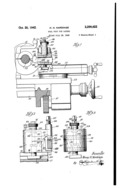The standard histories of the machine tool industry trace the origins of the famous Hardinge firm of machine tool makers (now the Hardinge Group) to the founding in 1890-07-23 of Hardinge Brothers in Chicago by Franklin Hardinge and Henry H. Hardinge. Their startup was difficult, and upon obtaining new financial backing they changed their firm's name to "The Horological Tool Company," In 1894 they changed back to Hardinge Brothers. (See, for example, the "History of the HARDINGE Machine-Tool Company" on Tony Griffith's comprehensive "lathes.co.uk" site: www.lathes.co.uk/hardinge/page4.html)
Henry H. Hardinge left Hardinge Brothers in 1895, and nearly leaves the historical record. Griffiths says "what prompted this move [to leave Hardinge Bros.] is unknown." A Henry H. Hardinge of Oak Park, Illinois (a Chicago suburb) appears in several contemporary sources as a political candidate and a speaker on tax issues.
A genealogical site (longislandsurnames.com) lists "Henry Hutchins Hardinge" as born 1863-05-07 in Warkworth, Ontario and deceased 1946-02-23 in Chicago. The "Notes" on this page indicate that this is almost certainly the same Henry H. Hardinge who co-founded Hardinge Bros. (See: www.longislandsurnames.com/genealogy/getperson.php?personID=l11461&tree=Hawkins; you'll have to re-type that URL, as the ampersand won't survive text processing).
To pick up a different thread, the following summary of the origins of the Advance Type Foundry appeared in the "Trade Notes" section of The Inland Printer, Vol. 50, No. 6 (March, 1913): 914. Note, however, that the spelling Wiebking's name (here "Weibking") is incorrect; the correct spelling of "Wiebking" is confirmed by the ads placed by the firm.
The dates match, and it would be unlikely that there were two Henry H. Hardinge's practicing engineering in Chicago at this exact moment. It would seem, therefore, that the co-principal in Wiebking, Hardinge & Co. and Advance Type Foundry was not just any tinkerer with typecasting machinery, but the co-founder of what remains perhaps the most prestigious machine tool firm in US history.
During the period in which Wiebking, Hardinge & Co. existed, Robert Wiebking's did some of the most important typographical matrix engraving of his time (e.g., most of Goudy's early typefaces). He is typically cited during this period as an individual, but one presumes that he was working as a co-principal of his firm.
The contributiones of Hardinge to the development of the Wiebking pantograph (almost certainly developed from the German pantograph brought to the US by Herman Wiebking, Robert Wiebking's father) is unknown. Indeed, very little is known about this pantograph.
It would appear, however, that during this period Hardinge was actively at work developing typecasting machinery. At least four patents were issued to him in this period, all for type-casting machines and all assigned to Wiebking, Hardinge & Co. See the discussion of Hardinge Typecaster. It seems clear that this machinery, together with Wiebking's matrices, formed the technical basis of Advance Type Foundry. There is no record of which I am aware of this typecasting machinery having itself been produced for sale; it would appear to have been used internally only.
Wiebking and Hardinge's Advance Type Foundry merged into the Western Type Foundry in 1914. Wiebking appears to have continued with Western. While at least one modern source says that his partnership with Hardinge dissolved at this point, I have not been able to find any contemporary evidence which says anything about the disposition of Wiebking, Hardinge and Co. or whether at this time Hardinge went also to Western or left to continue independently.
It would seem likely, though, that he did continue independently. In 1915, he was issued a patent for a slug-casting composing machine. This patent had been filed in 1910 (while he was with Wiebking, Hardinge & Co., and indeed before the startup of Advance Type Foundry). It was not assinged to that firm, however, but rather was assigned to Josiah Crotty. A search on Crotty indicates that he was a prominent Chicago lawyer engaged in a number of entrepreneurial businesses. There is no indication, however, that this linecaster was ever manufactured. It is not mentioned in Huss' The Development of Printers' Mechanical Typesetting Methods: 1822-1925 .

US Patent 1,131,643 (1915)
US patent 1,131,643. "Composing-Machine." Issued 1915-03-09 to Henry H. Hardinge. Filed 1910-12-23 as application serial number 598,961. Assigned to Josiah Cratty.
Considerably later, in 1942 Hardinge was issued another patent. (filed in 1940, when he was 77, six years before his death). This patent, US 2,299,622, was for a lathe tool post. Interestingly it was not assigned to the Hardinge firm that his brother had continued.

US Patent 2,299,622 (1942)
US patent 2,299,622. "Tool Post for Lathes." Issued 1942-10-20 to Henry H. Hardinge. Filed 1940-07-19 as application serial number 346,339. Not assigned.
The extract from The Inland Printer reproduced here is in the public domain.
US patent specifications are in the public domain by law.
All portions of this document not noted otherwise are Copyright © 2012 by David M. MacMillan and Rollande Krandall.
Circuitous Root is a Registered Trademark of David M. MacMillan and Rollande Krandall.
This work is licensed under the Creative Commons "Attribution - ShareAlike" license. See http://creativecommons.org/licenses/by-sa/3.0/ for its terms.
Presented originally by Circuitous Root®
Select Resolution: 0 [other resolutions temporarily disabled due to lack of disk space]